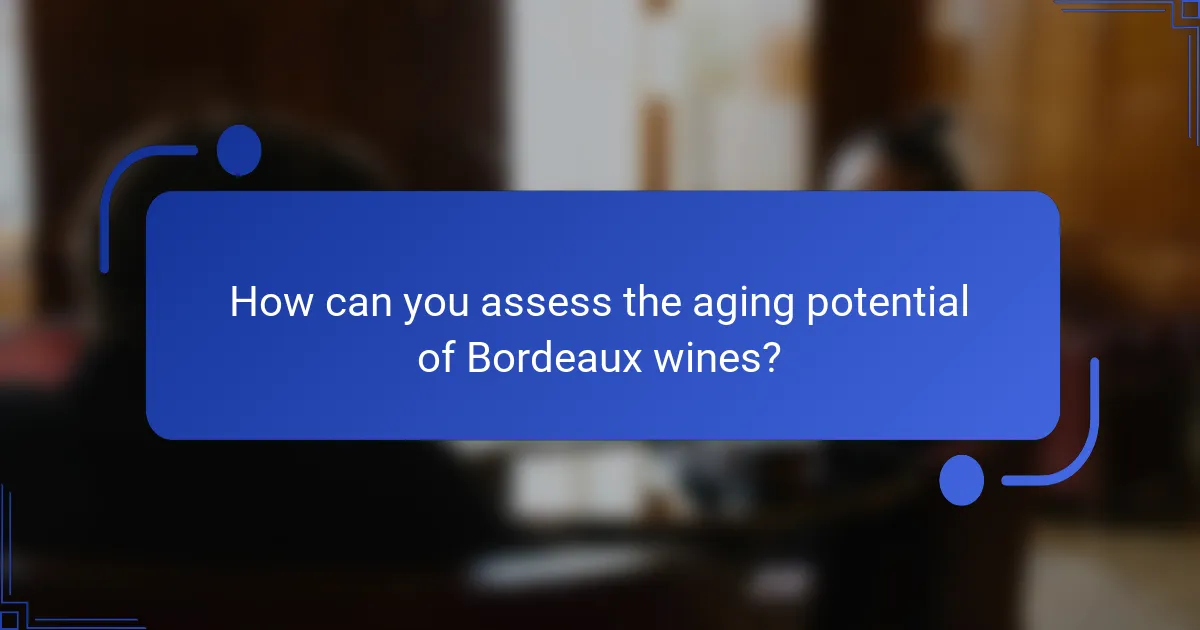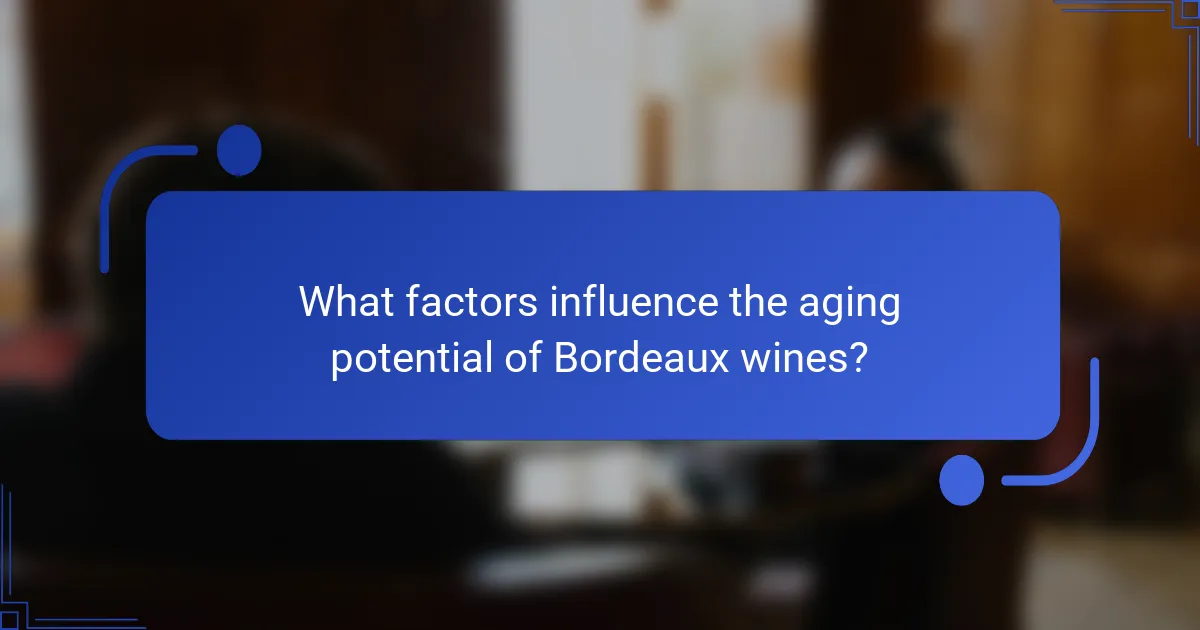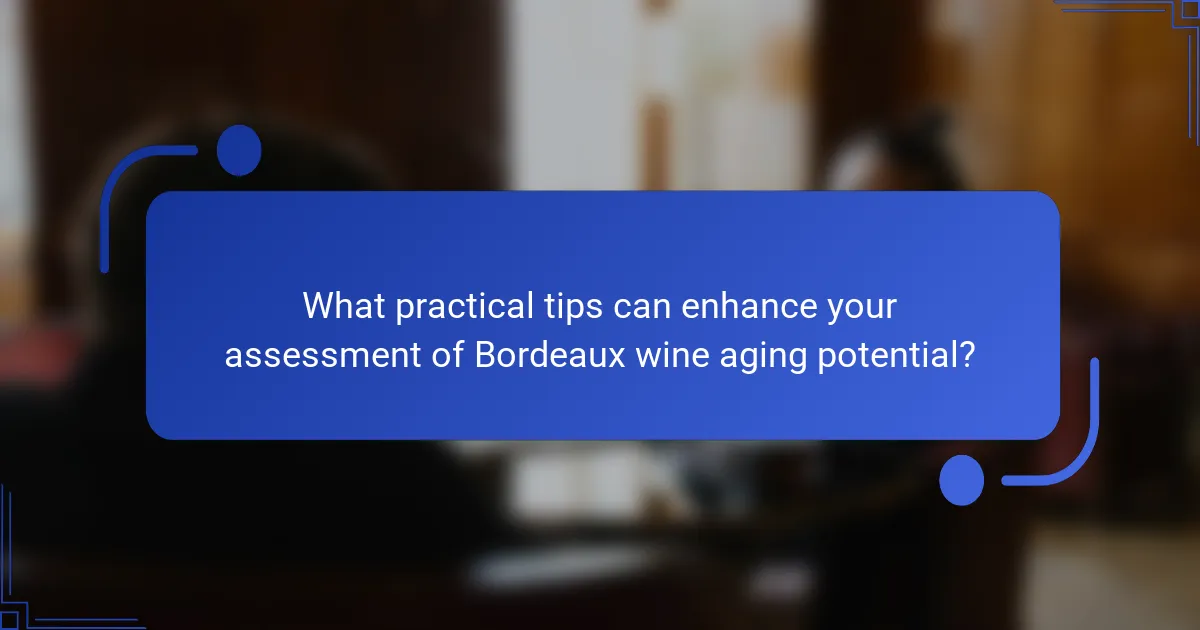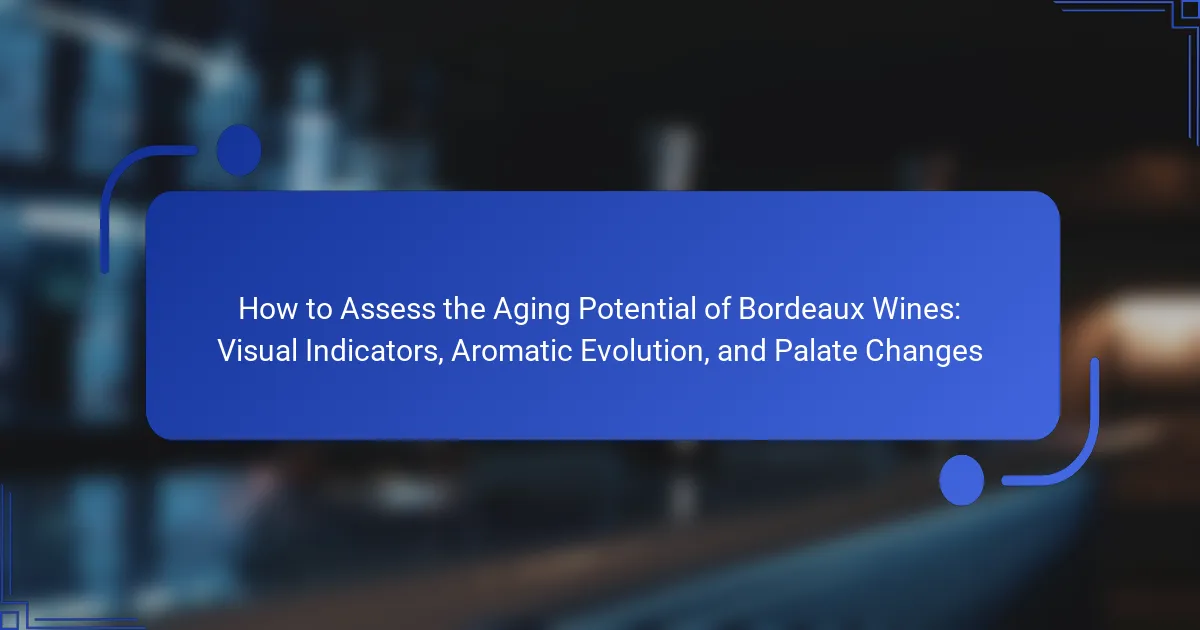
How can you assess the aging potential of Bordeaux wines?
To assess the aging potential of Bordeaux wines, evaluate their tannin structure, acidity, and fruit concentration. High tannin levels indicate better aging potential. Acidity helps preserve the wine over time. Concentrated fruit flavors suggest longevity.
Visual indicators include color intensity and clarity. Darker colors often signify richer wines that can age longer. Clarity reflects the wine’s stability.
Aromatic evolution is crucial for assessment. Complex aromas develop with age. Look for secondary and tertiary notes like leather, tobacco, or spices.
Palate changes also indicate aging potential. A balanced palate with a long finish suggests good aging capacity.
Historical data supports these assessments. Many Bordeaux wines have shown remarkable aging potential, with some lasting over 50 years.
What visual indicators should you look for in Bordeaux wines?
Look for clarity, color intensity, and rim variation in Bordeaux wines. Clarity indicates filtration and quality. A deep, vibrant color suggests youthfulness and concentration. As Bordeaux wines age, the color may shift from purple to garnet. The rim variation, where the color fades at the edge, indicates maturity. A wide, lighter rim shows older age. These visual indicators help assess the wine’s aging potential.
How does color intensity indicate aging potential?
Color intensity is a key indicator of aging potential in Bordeaux wines. Darker colors often suggest a higher concentration of phenolic compounds. These compounds, such as anthocyanins, contribute to the wine’s color and flavor profile. As wines age, color tends to evolve, typically becoming lighter. A wine with deep color may indicate robust structure and longevity. Conversely, a wine that has lost color intensity may indicate it is past its peak. Studies have shown that wines with greater color intensity can age longer and develop more complex flavors over time. This relationship between color and aging potential is a critical factor in wine assessment.
What sediment presence reveals about a wine’s age?
Sediment presence in wine typically indicates its age. As wine ages, compounds like tannins and color pigments precipitate, forming sediment. This process is more pronounced in red wines due to higher tannin levels. Older wines often have more sediment, which can affect clarity. For example, sediment in a Bordeaux wine may suggest it has been aged for several years. Winemakers often filter young wines to remove sediment. Therefore, the presence of sediment can serve as a visual cue for assessing a wine’s aging potential.
What are the aromatic evolution stages of Bordeaux wines?
Bordeaux wines undergo several aromatic evolution stages as they age. Initially, young Bordeaux wines exhibit primary aromas. These include fresh fruit and floral notes. As the wine matures, secondary aromas develop. These are derived from fermentation and include buttery and yeasty characteristics.
In further aging, tertiary aromas emerge. These include complex notes such as leather, tobacco, and dried fruit. The transition between these stages can vary based on the wine’s grape variety and aging conditions.
Research indicates that these stages can be observed over a typical aging period of 5 to 20 years. The aromatic profile can significantly influence the wine’s overall quality and enjoyment.
How do primary aromas change as Bordeaux wines age?
As Bordeaux wines age, primary aromas evolve significantly. Initially, these wines exhibit fruity and floral notes. Over time, these vibrant aromas transition into more complex characteristics. Fruity scents often give way to earthy, herbal, and spicy nuances. The aging process also enhances tertiary aromas, such as leather and tobacco. These changes occur due to chemical reactions, particularly oxidation and polymerization. Research indicates that aging can soften tannins, further altering the aromatic profile. The transition typically spans several years, depending on the wine’s structure and storage conditions.
What secondary and tertiary aromas should you expect over time?
Secondary aromas you can expect over time in Bordeaux wines include earthy notes, leather, and tobacco. These aromas develop as the wine ages and interact with oxygen. Tertiary aromas often consist of dried fruits, spice, and floral notes. These evolve further as the wine matures, adding complexity to its profile. The transformation of these aromas is a result of chemical reactions that occur during aging. For example, the breakdown of phenolic compounds contributes to the emergence of these secondary and tertiary notes. Studies indicate that aging can significantly enhance the aromatic complexity of Bordeaux wines, making them more nuanced and layered.
How do palate changes reflect the aging potential of Bordeaux wines?
Palate changes indicate the aging potential of Bordeaux wines through evolving taste profiles. As Bordeaux wines age, their tannins soften, leading to a smoother mouthfeel. This softening is a sign of maturation and complexity. Additionally, aged Bordeaux often exhibits a shift from fruity flavors to more earthy or tertiary notes. These changes reflect the development of complexity over time. For example, younger Bordeaux wines may present bold fruit flavors, while older vintages can reveal nuances of leather, tobacco, or spice. Such palate evolution is essential for assessing quality and aging potential. The ability to identify these changes can guide wine enthusiasts in selecting wines for aging.
What texture and mouthfeel changes occur with aging?
Aging in Bordeaux wines leads to significant changes in texture and mouthfeel. Initially, young wines exhibit a firm tannic structure. As they age, tannins soften and integrate, resulting in a smoother mouthfeel. The wine’s body can also become more rounded and less astringent over time.
Aging enhances the complexity of the texture, often introducing velvety or silky sensations. Additionally, the interaction between tannins and other components can create a greater sense of fullness. The overall mouthfeel may evolve from a sharp, youthful quality to a more harmonious and balanced profile.
Research indicates that these changes are influenced by chemical reactions occurring during aging, including polymerization of tannins and the development of secondary compounds. Such transformations contribute to the wine’s sensory experience, making aged Bordeaux wines particularly sought after for their refined texture and mouthfeel.
How do flavor profiles evolve as Bordeaux wines mature?
Bordeaux wines experience significant evolution in flavor profiles as they mature. Initially, young Bordeaux wines exhibit vibrant fruit flavors, such as blackcurrant, cherry, and plum. As they age, these fruity notes begin to soften and integrate. Secondary flavors, including leather, tobacco, and earthy characteristics, emerge during maturation. Tertiary flavors, like dried fruit and spice, develop further as the wine continues to age. This transformation is influenced by the wine’s tannin structure, acidity, and oak influence. Over time, the tannins become smoother, enhancing the wine’s overall balance. The aging process can last from several years to decades, depending on the specific Bordeaux wine. Studies show that optimal aging can enhance complexity and depth, making mature Bordeaux wines highly sought after.

What factors influence the aging potential of Bordeaux wines?
The aging potential of Bordeaux wines is influenced by several key factors. These include grape variety, tannin levels, acidity, and alcohol content. Bordeaux wines typically feature grape varieties such as Cabernet Sauvignon, Merlot, and Cabernet Franc. These varieties contribute to the wine’s structure and complexity. High tannin levels enhance the wine’s ability to age. Tannins act as a natural preservative, allowing the wine to develop over time.
Acidity plays a crucial role in aging potential. Wines with higher acidity tend to age better, as acidity helps maintain freshness. Alcohol content also affects aging; wines with moderate to high alcohol levels generally have better aging capacity. The wine’s terroir, including soil and climate, impacts flavor development and aging potential as well. Finally, winemaking techniques, such as oak aging and blending, further influence the wine’s ability to mature gracefully.
How does grape variety affect aging potential?
Grape variety significantly influences the aging potential of wines. Different grape varieties possess unique chemical compositions. These compositions affect the wine’s tannins, acidity, and phenolic compounds. Higher tannin levels typically enhance a wine’s ability to age. For instance, Cabernet Sauvignon is known for its robust tannins, allowing it to age well over decades. In contrast, lighter varieties like Pinot Noir may have lower aging potential due to softer tannins. Additionally, acidity plays a crucial role in preservation. Varieties with higher acidity, such as Riesling, can also age gracefully. Studies indicate that wines made from certain varieties can improve in complexity over time. Therefore, grape variety is a key determinant in a wine’s aging potential.
Which grape varieties are most suitable for aging?
Cabernet Sauvignon, Merlot, and Petit Verdot are the grape varieties most suitable for aging. These varieties are known for their high tannin levels and acidity. Cabernet Sauvignon often develops complex flavors over time. Merlot provides a softer texture while still aging well. Petit Verdot contributes color and structure, enhancing aging potential. Bordeaux wines, primarily made from these grapes, can age for decades. Historical evidence shows that well-cellared Bordeaux can improve for 10 to 30 years or more.
What role does tannin structure play in aging potential?
Tannin structure significantly influences the aging potential of wines. Tannins are polyphenolic compounds that contribute to a wine’s astringency and mouthfeel. Their structure determines how they interact with other components in the wine, such as acids and sugars. Wines with a higher proportion of larger, more complex tannins tend to age better. These tannins form stable bonds with proteins and other phenolic compounds over time. This process can enhance the wine’s texture and flavor complexity as it matures. Research shows that well-structured tannins can lead to a more harmonious aging process. For example, studies indicate that tannins from grape skins and seeds provide better aging potential than those derived from oak.
What environmental conditions impact the aging of Bordeaux wines?
Temperature, humidity, light, and air quality significantly impact the aging of Bordeaux wines. Optimal aging occurs at a stable temperature, ideally between 12°C to 15°C. Fluctuations in temperature can lead to premature aging or spoilage. High humidity levels, around 70%, help keep corks moist and prevent oxidation. Insufficient humidity can cause corks to dry out, allowing air to enter the bottle. Exposure to light, especially UV rays, can degrade wine quality and alter flavors. Finally, air quality affects the wine’s exposure to oxygen. Controlled oxygen levels are crucial for proper aging. These environmental conditions are essential for preserving the integrity and enhancing the complexity of Bordeaux wines over time.
How does storage temperature affect wine aging?
Storage temperature significantly affects wine aging. Optimal storage temperature for aging wine is typically between 50°F to 59°F (10°C to 15°C). At these temperatures, chemical reactions in the wine occur at a balanced rate. Higher temperatures can accelerate aging, leading to the loss of flavor and aroma. Conversely, lower temperatures may slow down aging excessively, preventing wine from reaching its full potential. Studies indicate that wines stored at temperatures above 70°F (21°C) can develop off-flavors and spoilage more rapidly. Proper temperature control is crucial for preserving the wine’s integrity and enhancing its aging process.
What humidity levels are ideal for aging Bordeaux wines?
Ideal humidity levels for aging Bordeaux wines are between 60% and 80%. This range helps maintain the integrity of the corks. Proper humidity prevents corks from drying out. When corks dry, they can allow air into the bottle. Excessive humidity can promote mold growth. Mold can damage labels and storage conditions. Maintaining this humidity range supports optimal aging. Studies show that controlled environments enhance wine quality over time.

What practical tips can enhance your assessment of Bordeaux wine aging potential?
To enhance your assessment of Bordeaux wine aging potential, focus on several key factors. First, evaluate the wine’s tannin structure. Higher tannin levels often indicate better aging potential. Next, assess acidity. Wines with balanced acidity can age gracefully. Examine the color intensity. Darker wines generally have more aging potential. Consider the grape variety. Cabernet Sauvignon typically ages better than Merlot. Analyze the wine’s vintage. Certain years produce wines with greater longevity. Lastly, monitor aromatic complexity over time. Developing aromas signal positive aging. These tips are grounded in wine evaluation standards, which emphasize structural components for aging potential.
How can you effectively evaluate a Bordeaux wine before purchase?
To effectively evaluate a Bordeaux wine before purchase, examine its visual, aromatic, and taste characteristics. Start by assessing the color clarity and intensity, which indicate age and quality. A deeper color often suggests a younger wine, while lighter hues may indicate aging. Next, swirl the wine to release its aromas. Smell for complexity, which is a sign of quality and potential aging. Identify fruit, floral, and earthy notes as indicators of the wine’s profile. Finally, taste the wine, focusing on its balance of acidity, tannins, and sweetness. A well-structured wine will have a lingering finish, suggesting good aging potential. These methods align with expert recommendations in wine evaluation.
What tools can assist in assessing the aging potential of Bordeaux wines?
Tools that assist in assessing the aging potential of Bordeaux wines include analytical instruments and sensory evaluation methods. Spectrophotometry measures color intensity, indicating oxidation levels. Gas chromatography analyzes aromatic compounds, revealing complexity and evolution over time. Tasting panels utilize sensory evaluation to assess flavor profiles and balance. Laboratory analysis of acidity and tannin levels provides insight into longevity. These tools collectively help determine the wine’s development potential and optimal drinking window.
How can a wine journal help track aging characteristics?
A wine journal helps track aging characteristics by documenting the development of a wine over time. It allows enthusiasts to record visual changes, such as color depth and clarity. Additionally, the journal captures aromatic evolution, noting shifts in scent profiles as the wine matures. Tasting notes can detail palate changes, including texture and flavor intensity. This systematic approach enables comparisons between different vintages and varietals. Over time, the collected data reveals patterns in aging potential. Studies indicate that consistent record-keeping enhances the understanding of how specific wines evolve.
What tasting techniques can improve your assessment skills?
Tasting techniques that can improve assessment skills include systematic evaluation, sensory training, and comparative tasting. Systematic evaluation involves using a structured approach to assess appearance, aroma, taste, and finish. Sensory training enhances the ability to identify specific flavors and aromas. Comparative tasting allows for direct comparison between wines, highlighting differences and similarities. Research shows that trained tasters can identify nuances better than untrained individuals. A study by the American Journal of Enology and Viticulture indicates that sensory training significantly improves wine assessment accuracy.
The primary entity of this article is Bordeaux wines, specifically focusing on their aging potential. Key factors for assessing aging potential include tannin structure, acidity, and fruit concentration, alongside visual indicators such as color intensity and clarity. The article delves into the aromatic evolution stages of Bordeaux wines, highlighting how primary, secondary, and tertiary aromas change over time, and discusses palate changes that reflect aging potential. Practical tips for evaluating Bordeaux wines before purchase and tools for assessing aging characteristics are also provided, offering a comprehensive guide for wine enthusiasts.
